Lecture01-Financial Statement
Analysis_and_interpretation_of_financial_statements_I

Analysis and Interpretation of Financial Statements –Part I BEA3005 Lecture 7Dr Chen LimSource: Black, G. (2009) Introduction to Accounting and Finance, 2nded. Harlow: Pearson Education LtdConsolidated Income Statement 2010 2009 For the year ended 31 December2010 2009 $m $m £m £m 33,269 32,804 Turnover 28,392 28,368 (7,592)(7,380)20,800 20,988 (13,053)(9,592)AstraZeneca GSK Consolidated Statement of Financial Position 2010 2009 As at 31 December 2010 2009 $m $m Non-current assets£m £m 6,957 7,307 Property, plant and equipment 9,045 9,374 3,606 3,361 8,532 8,183 97 68 AstraZenecaGSKROCE vs. ROEROCE: Capital employed includes all capital contributions; hence use the all-inclusive profit measure (i.e. PBIT).Profit Measures (IS )RecipientsCapital Employed (SFP )Ratio Profit before interest and taxAll the following:ROCEAdd: Interest income Less: Interest expenses Debt holdersInterest-bearing debts Less: Preference dividends *Preference shareholdersPreference share capitalProfit before tax Less: Taxation Profit after taxLess: Preference dividends *Preference shareholders Preference share capital Less: Non-controlling interests **Minority shareholders *Total equity less NCI *Profit attributable to owners of the parentOrdinary shareholders Total equity (parent only)ROE* Preference dividends will appear as finance cost (if the preference share capital takes on the nature of a liability).** Only applies when group accounts are prepared and subsidiaries are not 100%-owned by the parent company.%4181008,8871,634.=×)=++118091429174528,392.,,)60.8%10014,809291=×+$48.59 £11.68 £12.26 CalculationConsolidated Statement of Cash Flows2010 2009 For the year ended 31 December2010 2009 $m $m £m £m Cash flow from operating activities8,631 9,545(775)(780)(1,834)(1,704) AstraZeneca GSK210 269 Proceeds from sale of intangible assets 126 356 (34)(31)Purchase of equity investments (279)(154)5 3 Proceeds from sale of equity investments 27 59(11)Payments made by subsidiaries to NCI– –(1,868)(4,013)62 43%520110011,49413,854.=×%912710014,759.=×66016,78711,068.=5609,918.=。
The basic theory of financial statement-第一课2
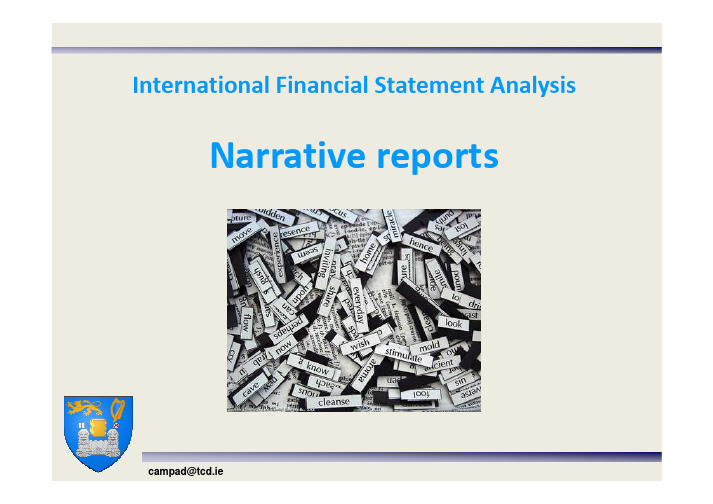
International Financial Statement Analysis Narrative reportsAnnual reportsType of information:Financial(Balance sheet,Income Statement,Cash flow statement,Changes in Equity).NarrativeNarrative reportsChairman and/or CEO’s statement.Director’s report(Including corporate governance report).Operating and financial reviewCSR(Corporate Social Responsibility)report.Auditor’s report.Notes to the accounts.Chairman’s statementNo legal requirement.Chairman’s comments in fairly general term in the company’s performance and prospect.Usually at the front of the Annual Report.Chairman’s statementContent:A brief account of the company’s financial and operating performance over previous year.Details of significant event that had a material effect on performance(e.g.significant acquisition/disposal).A summary of activities within key categories of the company.Reference to change in board membership.Outline new strategies,corporate goals or changes in focus or emphasis.An(often overoptimistic)assessment of future prospects.Director’s reportContent:Principal activities of the company and its subsidiaries.Assessment of future development of the business. Assessment of risks that could affect the company.A summary of activities within key categories of the company.Financial highlights.Presence of significant shareholders(shareholding greater than3%,in the UK).Director’s report –Corporategovernance reportThe system by which companies are directed and controlled (Cadbury Report,1992).Corporate governance refers to the structures,process,cultures and systems that engender the successful operation of the organization(Keasey&Wright,1993).Corporate governance is the process of supervision and control intended to ensure that the company’s management acts in accordance with the interests of the shareholders(Parkinson, 1994).The governance role is not concerned with the running of the business of the company per se,but with giving overall direction to the enterprise,with overseeing and controlling the executive actions of management and with satisfying legitimate expectations of accountability and regulation by interests beyond the corporate boundaries(Tricker,1984)Director’s report –Corporategovernance reportAssess Corporate Governance QualitySignificant relation between Corporate Governance characteristics and financial reporting qualityThe board of directorsThe board governs the company on behalf of the shareholders and is responsible for promoting their interests.It is led by a chairman and,for a listed public company,the board will normally include both executive and non-executive directors.Research reveals that companies’boards influence earnings management and the quality of financial position and structure is crucial.Small vs large boards.CEO duality.Executive vs non-executive directors.Boards’ committees Nomination committee.Audit committee.Remuneration committee.Director’s report –Corporate governancereportNames of any individual who held office as directors at any time during the period together with a little biography.Role of each director within the board(executive, NED,independent).Presence and composition of committees(Audit, remuneration,Executive,nomination).The interest of each director in shares,debentures, pension schemes.Details of any loan,credit-facilities extended to directors.Emoluments and type of remuneration of all directors.Operating and financial review Coherent narrative that provide a balanced and understandable presentation of the company’s performance.Main Content:Development and performance of the company during the financial year.Trend and factors underlying the development, performance and position of the business.Trend and factors which are likely to affect the entity’s future development,performance and position.CSR (Corporate Social Responsibility) report Achievement of adequate profitability taking care also of employees rights,employees’health and safety,social environment,communityMain Content:Relation with personal(remuneration,training,equality policies,etc.).Health and safety policies.Trend and factors which are likely to affect the entity’s future development,performance and position.Contribution to the development of social community. Anti-pollution policies.CSR (Corporate Social Responsibility) reportILVA Ltd Differences in comparison withthe rest of the county Cases of cancer among women (2002-2009)+100%Cases of children death within one year +20%Death rate (in general)+8% (W) +14%(M)Liver tumour +75% (W)+30% (M)CSR (Corporate Social Responsibility) reporte .i t . 22.10.2012Hodgkin's disease +43% (W) +30% (M)Uterus tumour +80% (W)Lung Tumour +48% (W) +50% (M)Stomach Tumour +100% (W) +30% (M)Breast tumour +24% (W)Pleura Tumour+103%(W) +167%(M)Death because of tumours +13%(W) +14%(M)Death because lung tumour+30%(W) + 33% (M)Death because of neoplasm due to the +211%(W) +416%(M)S o u r c e : w w w .c o r r i e r。
Unit 9 Financial statement
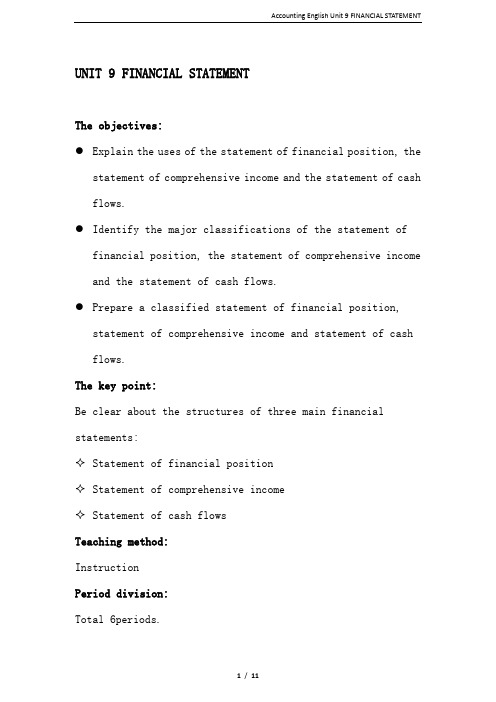
UNIT 9 FINANCIAL STATEMENTThe objectives:●Explain the uses of the statement of financial position, thestatement of comprehensive income and the statement of cash flows.●Identify the major classifications of the statement offinancial position, the statement of comprehensive income and the statement of cash flows.●Prepare a classified statement of financial position,statement of comprehensive income and statement of cash flows.The key point:Be clear about the structures of three main financial statements:✧Statement of financial position✧Statement of comprehensive income✧Statement of cash flowsTeaching method:InstructionPeriod division:Total 6periods.Content:I.Key words:✧Biological assets 生物资产英[,baɪə'lɒdʒɪkl]美[,baɪə'lɑdʒɪkl]adj. 生物学的;生物的;与生物学相关的;有血亲关系的n. [药]生物制品,生物制剂✧Non controlling interest (NCI) 非控制权益✧Utilities 公共事业英[ju:'tɪlɪtɪz] 美[ju'tɪlɪtɪz]n. [经济学]效用(utility的名词复数);实用;公用事业;神庙逃亡游戏中的一次性道具✧Distribution cost 销售成本英[,dɪstrɪ'bju:ʃn] 美[,dɪstrə'bjuʃən]n. 分配,分布;[法](无遗嘱死亡者的)财产分配;[无线]频率分布;[电]配电✧Administrative expenses 管理费用英[əd'mɪnɪstrətɪv] 美[əd'mɪnɪstreɪtɪv]adj. 管理的,行政的;行政职位;非战斗性行政勤务的✧Finance cost 财务成本英['faɪnæns] 美[fə'næns, faɪ-, 'faɪ,næns]n. 财政;金融;财源;资金vt. 为…供给资金,从事金融活动;赊货给…;掌握财政✧Performance 业绩英[pə'fɔ:məns] 美[pər'fɔrməns]n. 表演;演技;表现;执行✧Earnings per share (EPS) 每股盈余英['ɜ:nɪŋz] 美['ɜrnɪŋz]n. 收入,所得;工资,报酬;收益,利润✧Liquidity 流动性,偿债能力英[lɪ'kwɪdəti] 美[lɪ'kwɪdɪti]n. 流动性;流动资金;资产流动性;<财>资产折现力✧Solvency 偿付能力英['sɒlvənsi] 美['sɑlvənsi]n. <化>溶解状态,溶解力;偿付能力✧Operating activity 经营活动英['ɒpəreɪtɪŋ]美['ɑpə,retɪŋ]adj. 操作的;营运的;业务上的;外科手术的v. 操作( operate的现在分词);运转;管理;做外科手术英[æk'tɪvəti] 美[æk'tɪvɪti]n. 活动;活跃,敏捷;活动力;教育活动✧Investing activity 投资活动英[ɪnvestɪŋ] 美[ɪnvestɪŋ]v. 投资,花费( invest的现在分词);授予;(把资金)投入;投入(时间、精力等)✧Financing activity 筹资活动[fai'nænsiŋ]n. 筹措资金;理财;筹集资金;融资v. 为…供给资金,从事金融活动( finance的现在分词)II.IAS1 Presentation of financial statementsShows the objective of financial statements is to provide information about the financial position, financial performance, and cash flows of an entity that is useful to a wide range of users in making economic decisions. To meet that objective, financial statements provide information about an entity’s:✧Assets✧Liabilities✧Equity✧Income and expenses, including gains and losses✧Contributions by and distributions to owners✧Cash flowsIAS1 presentation of financial statement requires the components of a complete set of financial statement are:✧Statement of financial position✧Statement of comprehensive income✧Statement of cash flows✧Statement of changes in equity✧Note, including a summary of significant accountingpolicies and other explanatory information.✧Statement of financial position at the beginning of theearliest comparative period when an entity applies anaccounting policy.III.Statement of financial position 财务状况表1.The journal entries of main business transactionsa)Sales of goodsb)Purchase of inventory for resalec)Purchase of non-current assetsd)Payment of expenses such as utilitiese)Introduction of new capital to the businessf)Distribution of dividendsDetails refer to page113-114.2.Items in the statement of financial positionThe standard specifies minimum headings (if they exist at the date of financial statement) to be presented on the face of the balance as follows:a)Property, plant and equipment(PPE).b)Investment property.c)Intangible asset.d)Financial asset.e)Biological assets.f)Inventory.g)Trade and other receivables.h)Cash and cash equivalents.i)Trade and other payables.j)Provisions.k)Financial liabilities.l)Current tax.m)Deferred tax.n)Non controlling interest (NCI).o)Capital and reserves.IV.Statement of comprehensive income 综合收益表Minimum items on the face of the statement ofcomprehensive income should include:a)Revenue.b)Finance costs.c)Share of the profit or loss of associates and jointventures.d)Pre-tax gain or loss recognized on the disposal ofassets etc.e)Tax expense.f)Profit or loss.g)Each component of other comprehensive incomeclassified by nature.h)Profit or loss for the period attributable tonon-controlling interests and owners of the parent.i)Total comprehensive income attributable tonon-controlling interests and owners of the parent. V.Statement of cash flows 现金流量表i.Three classifications of statement of cash flows●Operating activities (relating to the main revenue producing activities)a.Cash receipts from the sale of goods and the rendering of servicesb.Cash receipts from royalties (e.g. franchising, licensing), fees,commissions and other revenuec.Cash payments to suppliers for goods and servicesd.Cash payments to and on behalf of employeese.Cash payments of taxes etc.●Investing activities (acquisition and disposition of PPE and othernon-current assets, which are not for the trading purposes)a.Cash payments to acquire property, plant and equipment, intangibles andother non-current assetb.Cash receipts from sales of property, plant and equipment, intangibles andother non-current assetc.Cash payments to acquire debt and equity instrument of other entities.d.Cash receipts from disposal of debt and equity instrument of other entities,etc.Financing activities (obtaining resources from owners or through borrowings and returning resources to the owners)Cash receipts from customers Xa.Cash proceeds from issuing shares.b.Cash payments to owners to acquire or redeem the entity’s shares.c.Cash proceeds from issuing debentures, loans, notes, bonds and otherborrowings.d.Cash repayments of amounts borrowed, etc.ii.Direct and indirect method for calculating cash from operation activities1.Direct methodThe direct method shows each major class of gross cash receipts and gross cash payments. It is the simply way to extract the information from the accounting record.The operating cash flows section of the statement of cash flows under the direct method would appear something like this:Cash paid to suppliers(X)Cash paid to employees(X)Cash paid for other operating expenses(X)Interest paid(X)Income taxes paid(X)Net cash from operating activities X2.Indirect methodThe indirect method adjusts accrual basis net profit or loss for the effects ofnon-cash transactions.The operating cash flows section of the statement ofcash flows under the indirect method would appear something like this:Operating profit (income statement) X Add depreciation X Loss (profit) on sale of non-current assets X (Increase)/decrease in inventories(X)/X (Increase)/decrease in receivables(X)/X Increase/(decrease) in payables X/(X) Cash generated from operations X Interest (paid) (X) Income taxes paid (X) Net cash flows from operating activities X 3.The reasons why certain items are added and others subtracted are asfollows:a.Expense which not generate cash outflowSuch as depreciation and amortisation is not a cash expense, but has been deducted in arriving at the profit figure. Therefore, to eliminate it by adding it back.b.Expense which not involved in the operating activitiesSuch as a loss on disposal of a non-current asset needs to be added back and a profit deducted.c.Changes of current asset except cash●we have spent cash on buying inventory so the increase in inventoriesmeans less cash.●An increase in receivables means the company’s debtors have not beenpaid as much, and therefore there is less cash.d.Changes of current liabilityIf we pay off payables by cash, causing the amount of payable to decrease, again we have less cash.Summary:Students should be familiar with the detail frame of the three main financial statements. Especially the statement of cash flow, because the content within the cash flow statement is notAccounting English Unit 9 FINANCIAL STATEMENT only simple as the cash payment and cash receipt.STATEMENT OF CASH FLOWSThe objectives:●Explain the uses of the statement of cash flows.●Identify the major classifications of the statement of cash flows.●Prepare a classified statement of cash flows.The key point:Be clear about the structures of the statement of cash flows:✧Operating activities✧Investing activities✧Financing activitiesTeaching method:Instruction, illustration, discussionPeriod division:Total 6periods.Content:Summary:Students should be familiar with the three classifications of cash flow statement. Especially the reasons of the addings and deductions for the operating cash flows under indirect method.11 / 11。
《会计专业英语》Chapter 8 Financial Statements
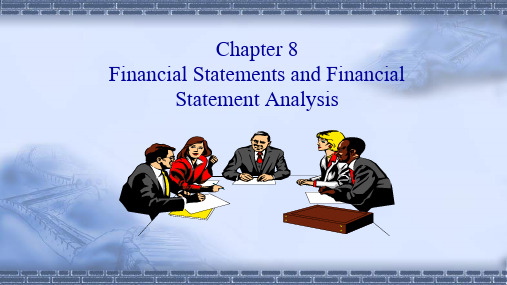
6
8.1.2 Income Statement
1. The Purpose of an Income Statement ➢ An Income Statement is a financial statement that summarizes the
profitability of a business entity for a specified period of time. ➢ Tlp users of financial statements:
➢ Information in the Income Statement not only helps users evaluate past performance, but also provides insights into the likelihood of achieving a particular level of cash flows in the future.
7
2. The Elements of an Income Statement
➢ The Income Statement classifies amounts into gross profit on sales, income from operations, income before taxes, and net income.
Lecture+01+Introduction+to+Financial+Accounting+-+PDF
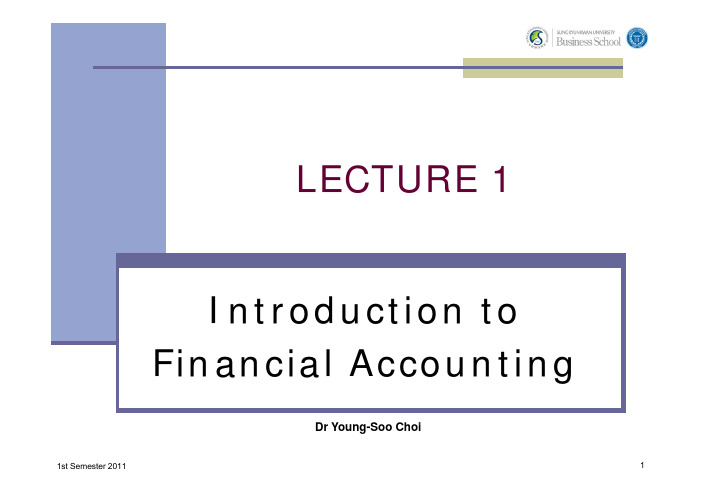
1st Semester 2011
7
Overview of IASB’s Conceptual Framework (continued)
The Framework is divided into seven major sections: The objectives and users of financial statements Underlying assumptions Qualitative characteristics of accounting information The elements of financial statements Recognition of the elements of financial statements Measurement of the elements of financial statements Concepts of capital and capital maintenance The Framework cannot be ignored: IAS 8 (Accounting Policies, Policies Changes in Accounting Estimates and Errors) states that in the absence of a specific standard addressing an issue, an entity is required to look at the Framework However, the Framework does not override any specific IASB standard if there appears to be a conflict.
Lecture-2-financial-statement-analysis

(快照)
Long-term debt
Shareholders’ equity
total assets ≡ total liabilities + owners’ equity
Uses of funds ≡ Sources of funds
5
第5页,共72页。
Investing activities: acquisitions and divestitures of long-term assets.(如购置或出售长期固定资产)
Financing activities: issuances and payments toward equity, borrowings, and long-term liabilities.(如发行债务、偿还债务、发行新股)
年度
2001
Lecture 2 Financial Statements Analysis
1
第1页,共72页。
Outline of Lecture 2
Demand and Supply of Financial Analysis Primary Types of Financial Statements Techniques of Financial Statements Analysis Earnings Quality
Long-term debt
Fixed Assets:
Long-term Investments(长期投资) Property, plant and equipment(固定资产)
Shareholders’ Equity
Common Stock(普通股股本)
会计英语课件:Interpretation of Financial Statements

▪ Ratio analysis is a useful tool to indicate specific areas of a business which merit further investigation.
▪ The calculation of relevant ratios will provide the user with a number of pertinent questions to which there may be a number of alternative answers.
Return on capital employed/Return on net assets
Company A $10 000 $30 000 33.3%
Company B $50 000 $200 000 25%
It would now appear that Company A is more profitable than Company B as Company A has made better use of its resources.
▪ (2)An awareness of the users of financial statements and their specific needs;
▪ (3)An understanding of the deficiencies of the financial statements, especially where historical cost accounting has been used;
▪ 3. To develop the ability to analyze the financial statements of an organization.
lecture_1

12
Users and theirnagers Investors/ Owners Employees
Government Customers Suppliers/ Creditors
Business Organisation
Lenders
Measurement Financial
4
Financial Accounting - Functions
Recording Record transactions, revenue, borrowing. Processing Processing is the way the recorded data is turned into financial information. Presenting Presenting financial statements such as Income Statement, Balance Sheet, Cash Flow Statement and etc.
6
Conceptual Framework
‘A conceptual framework for accounting is a statement of principles which provides generally accepted guidance for the development of new reporting practices and for challenging and evaluating the existing practices’ (Weetman, 2006).
11
Conceptual Framework
The structure of most conceptual frameworks:
Lecture 2 Financial Statement
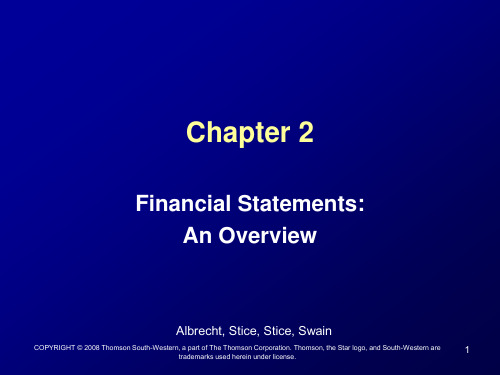
7
The Income Statement
Revenues Increase in a company’s resources from the sale of goods or services. Expenses Costs incurred in the normal course of business to generate revenues. Net Income or (Net Loss) Revenues - Expenses
Owners’ Equity
Paid-in Capital Retained earnings Total liabilities and owners’ equity
Must Equal
Classified and Comparative Balance Sheets
• Classified balance sheet
Owners and managers want the most favorable results possible. • Bank credit • Bonuses • Public stock price CPA firms have economic incentives to perform credible audits. • Reputation • Lawsuits 15
13
External Audits
Audit Report
– Issued by an independent CPA firm. – Verifies financial statements have been prepared according to GAAP.
Analysis-of-Financial-statements
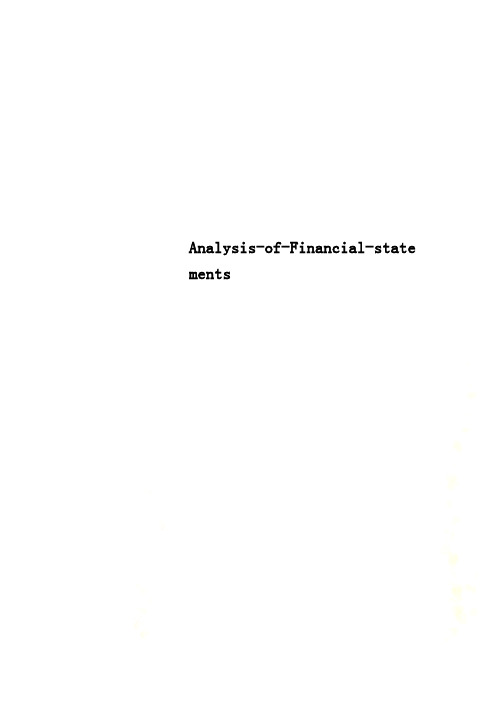
Analysis-of-Financial-state mentsANALYSIS OF FINANCIAL STATEMENTSNameJiacheng CaoPast and likely future of financial performance and financial position To analyze the past, present and future of Pulsins financial performance and position we have to use their financial statements and the financial ratios. The first ratios in consideration are the profitability ratios. The company’s gross profit margin (GPM) standsat 54%, and the net profit margin NPM stands at 25% as at 2013. The GPM has been kept between the ranges of 50% to 60% of the year 2008. It is due to the high levels of cost of sales arising from the use of high and new technology which results in high-quality products and thus higher sales levels (Subramanyam et al., 2009: 34). The NPM, however, has been rising from 5% to 25% in 2008 due to the company’s ability to control its expenditure. The profitability ratios are expected to remain in the same trend because the company had a five times administration and selling expenses in 2013 as that of 2012. Expansion of business and exportation of products to Germany explains the increased costs (Robinson, 2012: 86).The accepted liquidity ratios for businesses are always 1:1 or 2:1. The following table shows the liquidity ratios of the company over the period between 2006 and 2013. DATE 2006 2007 2008 2009 2010 2011 2012 VALUE 0.70 0.60 1.78 0.95 1.25 0.95 0.92The ratios have been on the rise from 2006 to 2008. In 2009, they fell and rose again in 2010. In 2011, it fell to 2012. The forecast indicates that the organization will maintain a favorable liquidity ratio above one by ensuring that it reduces the value of its trade creditors thus raising the ability of the company to meet its short-term obligations.The current ratio of the companyThe company’s earnings per share ratios (EPS) have also been increasing from £6 in 2008 to £2500 in 2014. The trend is expected to be continuing to the next period because the value per share will be rising as the result of increased confidence in the management of the owners of the company.Working capital analysis2007 2008 2009 2010 2011 2012Trade debtors 70,945 161,719 271,539 510,306 608,588 1,035,955 Stock 50,589 64,680 101,231 168,065 326,070 633,329 Trade creditors 117,833 140,092 303,537 427,991 715,777 1,307,765 3,701 173,351 86,068 273,924 291,040 531,994 WorkingCapitalThe working capital has indicated a rise in the value of the trade creditors and debtors. The 2010 to 2012 values are indicating a strong ability of the company to retain more of their customers. The trade creditors are more than the trade debtors because of increased demand and sales for the product. The trend is forecasted to remain the same due to expansion and the company exporting its products to Germany.BenchmarksThe best benchmark for the company is Innocent Smoothies Inc. because they have a similar nature of products and history. Innocent is growing through coordination while Pulsin through direction. It has given Pulsin a chance to look ahead and learn from the mistakes and achievements of Innocent because Innocent is standing more established growth process (Wahlen et al., 2010: 56).Pulsin has done well in maintaining a better profitability than Innocent in the beginning. The NPM of Innocent ranged between negatives and zero while that of Pulsin was between 20% and 25%. It was because Innocent did not exercise control over their expenses while pulsing did. It was also because innocent’s shares were bought byCoca-Cola while Pulsin kept it shares between its three directors. After Coca-Cola took over the business in 2009, there was slow decision-making, unlike Pulsin where the directors have control of the business and make fast decisions. The gearing ratios was above 100% until when 2009 because the business had encountered problems inability to pay their debts. Pulsin experienced the same problems but used the options to re-invest rather than borrowings from banks. They also made use of crowd borrowings whose interest rates were lower than those of the bank by about 3% to 5%.Pulsin, however, has been experiencing lower performance in terms of the OCC. Innocent has a higher OCC and lower inventory days as well as debtor days. Pulsin should avoid using more cash frequently by ensuring it improves its OCC level by ensuring the debtor and inventory days are below 30 days (Kopczynski, 1996: 37).Other factors like image protection and corporate responsibility have helped Innocent gain more sales than Innocent. It is because it allocates some part of the profits to enhance the company’s reputation thus increasing the customer confidence. Pulsin should learn from innocent’s strategy of using about 10% to 20% of their profit for donations to charities and adverts thus maintaining a healthy and ethical image.Lectur er’s presentationThe sales of Pulsin Ltd have performed well. In figure 1 the sales value has been increasing over the period from 2011 to 2013. Also it is notable the effect of innovation and introduction of new products as the protein powders which were new products in 2011 their sales volume has been increasing almost to that of the size of their top selling product.Last 3 years’ sales results1.6m bars & 64,000kg of protein powder in 2013Figure1 Source: Pulsin guest lecture slide, 2014As the company is travelling towards growth through direction in the second phase of the Greiner curve it is important to consider the sales direction (Fridson et al., 2011: 28). The company should focus on developing sales in the U.K internet and wholesale customers as they account for 70% of the total sales.In figure 2, the sales of products to the internet are highest at £1.59 per unit followed by wholesalers at £0.75 per unit and finally distributors at £0.7 per unit. The company should, therefore, focus more on the customers who will give them more sales and better profit margins.Moreover, in figure 3, it shows the problem of cash flow cycle could be solved because there are usually shorter payment periods with selling goods to wholesalers and on the UK internet. Therefore, the debtor days and OCC would be correspondingly declined (Feldman et al., 2007: 79).Moreover, in figure 3, it shows the problem of cash flow cycle could be solved because there are usually shorter payment periods with selling goods to wholesalers and on the UK internet (Bernstein, et al., 2000: 56). Therefore, the debtor days and OCC would be correspondingly declined.Figure2: Source: Pulsin guest lecture slide, 2014Figure three provides a solution to the problem of cash flow cycle. The debtor days in the OCC can be reduced by increasing the sales to wholesalers and the U.K internetbecause there are shorter payment periods. Sales margin & volumeDistributors/MultiplesWholesalers/Large Direct to store Direct to Store/independents/Pulsin ’ webshopVolume Margin High Low High LowPayment Terms0-30days30-45 days 45-60+daysFigure3Source:Pulsin guest lecture slide , 2014Recommendations and conclusionsPulsin has encountered many advantages due to its involvement in Research andDevelopment (R&D). It is due to the policy of the U.K government that any investment in R&D attracts a corporation tax relief of about 225% of the R&D. The company should, therefore, have structured research methods such as using Data Monitoring system and employing research companies to control the quality of the research. It will assist because the company will have reduced taxes thus more profits.The company keeps a favorable amount of cash in their financial statements because majority of transactions are carried out through cash. The holding of more cash can lead to sustainable growth in the future. Keeping a low gearing ratio which declines every yearenables the company to expand as it increases its reduces its reliance on debts (Atrill, 2013: 30).ReferencesAtrill, P. (2013). Financial Accounting for Decision Makers.Harlow, Pearson Education.?id=459576.Bernstein, L. A., & Wild, J. J. (2000).Analysis of financial statements.New York [u.a.], McGraw-Hill.Feldman, M., & Libman, A. (2007).Crash course in accounting and financial statement analysis.Hoboken, N.J., Wiley. /marc.asp?bookid=16885. Fridson, M. S., & Alvarez, F. (2011).Financial statement analysis workbook step-by-step exercises and tests to help you master financial statement analysis.Hoboken N.J.,Wiley./marc.asp?bookid=43202.Jablonsky, S. F., & Barsky, N. P. (2001).The manager's guide to financial statement analysis.New York, Wiley.Kopczynski, F. J. (1996). Prospective financial statement analysis. New York: Wiley. Peterson Drake, P., & Fabozzi, F. J. (2012).Analysis of financial statements.Robinson, T. R. (2012). International financial statement analysis.Hoboken, N.J., John Wiley & Sons./marc.asp?bookid=46147. Subramanyam, K. R., & Wild, J. J. (2009).Financial statement analysis. Boston, McGraw-Hill Irwin.Wahlen, J. M., Bradshaw, M., Baginski, S. P., & Stickney, C. P. (2010).Financial reporting, financial statement analysis, and valuation. Mason, Ohio, South-Western.。
财务管理专业英语 -Financial Statements
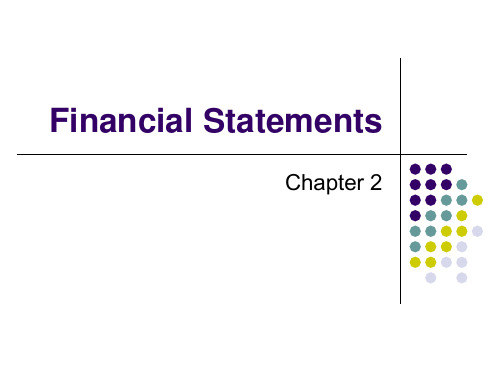
furniture; fixtures and fittings (items such as the shelves and counters in a shop).
2. Intangible Assets Intangible asset.mp3
6
Asset: Non-Current asset
Non-Current Assets
These have ‘lives’ longer than current assets. They are assets of a more permanent nature.
Non-Current Assets are further divided (classified) into three groups:
Debt vs. equity
The basic feature of a debt is that it is a promise by the borrowing firm to repay a fixed dollar amount of by a certain date.
The shareholder’s claim on firm value is the residual amount that remains after the debtholders are paid.
3. Long-term Investment: These assets come from the
additional cash funds that the business invests in income-earning securities.
第3章 Financial Statements《会计英语》PPT课件

Total Assets
133 500
68 000
$350 000
Unit 1 Balance Sheet
Exhibit 3-1-1A balance sheet in report form
ABC Co. LTD
Balance Sheet
December 31, 20
Liabilities & Owners’Equity
$225 000
45 000
270 000
350 000
Unit 1 Balance Sheet
Exhibit 3-1-2 A balance sheet in account form
ABC Co. LTD
Balance Sheet
December 31, 20_ _
Assets
Cash
Accounts Receivable
ABC Co. LTD
Balance Sheet
December 31, 20
Assets
Cash
Accounts Receivable
Supplies
$20 500
65 000
1 500
Cleaning Equipment
39 000
Delivery Equipment
22 500
Buildings
business arrived at this financial position.
Unit 1 Balance Sheet
➢FORMAT OF BALANCE SHEET. The balance sheet may be arranged in
either account form or report form.
会计学(第21版)课件:Financial Statement Analysis
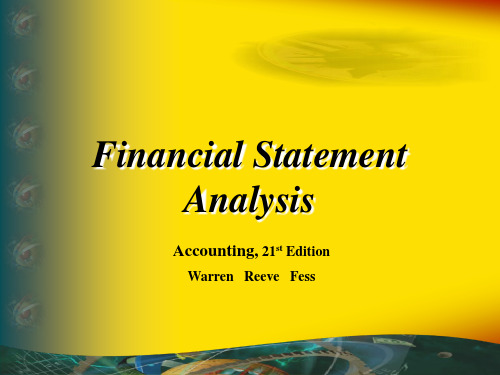
Balance Sheet
Increase (Decrease)
Assets
2006
2005 Amount Percent
Current assets
$ 550,000 $ 533,000 $ 17,000 3.2%
Long-term investments
95,000 177,500 (82,500) (46.5%)
$ D1201if00f,,e00r00e00nce$ 220403,,00$00(0082,$5(01(30003),,00=0000())46((.15530%..60%%) )) B$as3e1y0e,0a0r0(20$0454)3,0$01077,$5(01303,000) (30.0%)
Stockholders’ Equity
Financial Statement Analysis
Accounting, 21st Edition
Warren Reeve Fess
Some of the action has been automated, so click the mouse when you see this lightning bolt in the lower right-hand
Total liab. & SE
$1,139,500 $1230,500 $(91,000) (7.4%)
Lincoln Company
Comparative Balance Sheet
December 31, 2006 and 2005
Increase (Decrease)
Assets
2006
2005 Amount Percent
Total liab. & SE
会计英文教材第一集
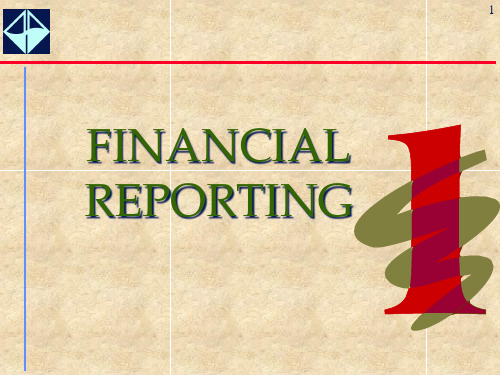
FINANCIAL REPORTING
2
Learning Objectives
Describe the purpose of financial reporting and identify the primary financial statements.
Explain the function of accounting standards and describe the role of the FASB in setting these standards in the United States.
company (thgeeansesreatste),d thcreorutagihn interval, the the compbaunsyin’sess oampeoruatnitoonfs cash generated obligation(sre(vtheneues), tahnednceotnsumed by a
FAF SEC
AICPA
Other
GASAC GASB FASAC FASB AcSEC U.S. Gov't
IAPC
EITF
IASC
Financial Accounting
21
Standards Board (1973-present)
Seven full-time memb body.
5
Definition for Accounting
“Accounting is a service activity. Its
function is to provide quantitative information, primarily financial in nature, about economic entities that is intended to be useful in making economic decisions--in making reasoned choices among alternative courses of action.” (APB 4.40).
财务会计 第一章the financial statements
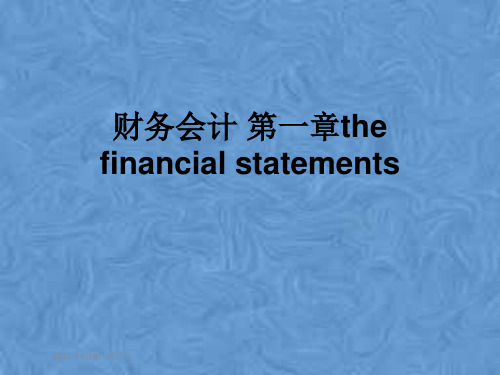
The basic component of contributed capital is common shares.
Retained earnings is the amount earned by income-producing activities and kept for use in the business.
The Financial Statements
Information Reported on the Financial Statements
Question
1. How well did the company perform (or operate) during the period?
2. Why did the company’s retained earnings change during the period?
Contributed capital
Retained earnings
Assets = Liabilities + Shareholders’ equity
Assets = Liabilities + Contributed capital + Retained earnings
The Accounting Equation
Assets are the economic resources of a business that are expected to produce a benefit in the future. Liabilities are “outsider claims”
03 Financial Statement 金融英语
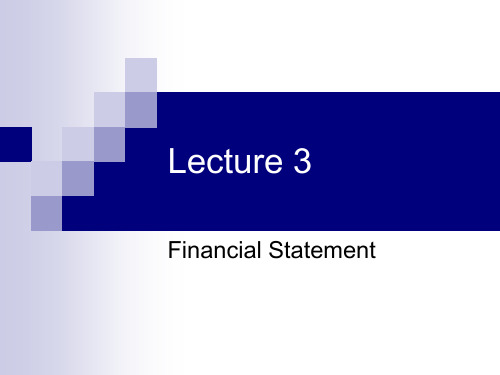
Cash and cash equivalents
现金及现金等价物 it is the most liquid asset, which includes currency, deposit accounts, and negotiable instruments (e.g., commercial paper, cheque, bank drafts).
5
Balance Sheet 资产负债表
An accounting statement of a company's assets and liabilities, provided for the benefit of shareholders and regulators. It gives a snapshot, at a specific point of time, of the assets that the company holds and how the assets have been financed.
7
Some words
Supplier 供应商 granting credit 授信 Debit 借方 Credit 贷方
8
Ownership equity 所有者权益
Shareholders' equity (or stockholders' equity, shareholders' funds, shareholders' capital employed) is this interest in remaining assets, spread among individual shareholders of common or preferred stock. After liabilities have been accounted for, the positive remainder is deemed the owner's interest in the business. 所有者权益,是指所有者在企业资产中享有的经 济利益,其金额为资产减去负债后的余额。
金融英语lecture1

金融英语L e c t u r e1M o n e y(总10页)--本页仅作为文档封面,使用时请直接删除即可----内页可以根据需求调整合适字体及大小--MoneyIf you can actually count your money, then you are not really a rich man.——American oil billionaire J. Paul Getty What is money?Economists define money as anything that is generally accepted in payment for goods or services or in the repayment of debts.Types of moneyA. Commodity moneyB. Convertible paper moneyC. Fiat money(or fiat currency):Usually paper money, is a type of currency whose only value is that a government made a fiat that the money is a legal method of exchange.Unlike commodity money or representative money it is not based in another commodity such as gold or silver andis not covered by a special reserve.D. Private debt moneyE. Electronic moneyPrivate debt moneyA loan that the borrower promises to repay in currencyon demand. . IOU the checkable deposit at commercial banks and other financial institutions.Commercial notes(商业票据):Short-term, unsecured, discounted, and negotiable notes sold by one company to another in order to satisfy immediate cash needs.Include: promissory note (期票,拮据) draft (汇票) check and so on.Electronic money: Electronic Check, Internet Payment System, Credit Card ServiceWhat does money do?A. Medium of ExchangeIn almost all market transactions in our economy, money in the form of currency or checks is a medium of exchange; it is used to pay for goods and services. The use of money as a medium of exchange promotes economic efficiency by eliminating much of the time spent in exchanging goods and services.Terms: Transaction cost, Time value of moneyB. Unit of AccountThe second role of money is to provide a unit of account; that is, it is used to measure value in the economy. We measure the value of goods and services interms of money, just as we measure weight in terms of pounds or distance in terms of miles.Note: Fiat money has not only no particular value in use; it doesn't even really have a value in exchange except that which is decreed that it would have.Terms: Good money, Bad moneyC. Store of ValueMoney also functions as a store of value: it is a repository of purchasing power over time. It is an asset. It 's something that we can use to store value away to be retrieved at a later point in time. So we can not consume today, we can hold money instead - and transfer that consumption power to some point in the future.Term: Hard currencyMeasuring Monetary Aggregates1. Measure as “money” only those assets that are most liquid, hence that function best as a medium of exchange.2. Include all financial assets in the measure of money, but weight them in proportion to their liquidity.1. M1 = Most Narrow Measure (Most Liquid)M1 = currency + traveler’s checks + demand deposits + other checkable deposits2. M2 = M1 + Less Liquid AssetsM2 = M1 + small denomination time deposits + savings deposits + money market deposit accounts + money market mutual fund shares3. M3 = M2 + Less Liquid AssetsMoney supplyThe revenue raised through the printing of money. When the government prints money to finance expenditure, it increases the money supply. The increase in the money supply, in turn, causes inflation. Printing money to raise revenue is like imposing an inflation tax.To expand the money supply:The Federal Reserve buys Treasury Bonds and pays for them with new money.To reduce the money supply:The Federal Reserve sells Treasury Bonds and receivesthe existing dollars and then destroys them.InflationInflation is an increase in the average level of prices, and a price is the rate at which money is exchanged for a good or service.Here is a great illustration of the power of inflation:In 1970, the New York Times cost 15 cents, the median price of a single-family home was $23,400, and the average wage in manufacturing was $ per hour. In 2008, the Times cost $, the price of a home was $183,300, and the average wage was $ per hour.Hyperinflation is defined as inflation that exceeds 50 percent per month, which is just over 1 percent a day. Questions1. Money is not unique as a store of value; any asset, be it money, stocks, bonds, land, houses, art, or jewelry, can be used to store wealth. Many such assets have advantages over money as a store of value: They often pay the owner a higher interest rate than money, experience price appreciation, and deliver services such as providing a roof over one's head. If these assets are a more desirable store of value than money, why do people hold money at all?The answer to this question relates to the important economic concept of liquidity.2. Rank the following assets from most liquid to leastliquid:a.Checking account depositsb. Housesc. Currencyd. Washing machinese. Savings depositsf. Common stock3. Why have some economists described money during a hyperinflation as a “hot potato” that is quickly passed from one person to another?4. Was money a better store of value in the United States in the 1950s than it was in the 1970s Why or why not In which period would you have been more willing to hold money5. In Brazil, a country that was undergoing a rapid inflation before 1994, many transactions were conducted in dollars rather than in Reals, the domestic currency. Why?Quiz1. Fiat money is:A. credit card chargesB. CoinsC. not convertible into precious metals.D. checks Answer: C2. Which of these is not a function of money in an economy?A. Store of valueB. Medium of exchangeC. Source of incomeD. Unit of account Answer:C3. Which of the following is not part of M1?A. checking accountsB. traveler's checksC. savings accountsD. currencyAnswer:C4. If Mary deposits $100 of her currency in her checking account, then:A. M1 will increase by $100.B. M2 will fall by $100.C. M1 and M2 will not change.D. M2 will increase by $100.Answer:C5. If Mary moves $100 from her savings account to herchecking account, then:A. M1 will not change.B. M2 will not change.C. M1 will fall by $100.D. M2 will fall by $100.Answer:B6. Which of the following is not part of M2?A. Small time depositsB. CurrencyC. Institutional money market mutual fundsD. Saving accountsAnswer:C7. Inefficiencies that are created when using checks as money include:A. Checks can transfer funds slowly.B. There are too many bad checks written.C. Checkbooks can be stolen.D. Checks can be written for any amount.Answer:A8. The liquidity of an asset is:A. the ability of an asset to earn interest income.B. the amount of an asset sold at discount or premium.C. the relative ease with which an asset can be converted into a medium of exchange.D. the relative ease with which an asset can be converted into a common stock.Answer:C9. For a commodity to function effectively as money, it mustA. Be widely accepted.B. Be backed by gold or silver.C. Be indestructible.D. Be printed by the government.Answer:A10. Money supply data is generated by:A. The Department of CommerceB. The Federal Deposit Insurance Corporation (FDIC)C. The Federal Reserve System (the Fed)D. The Treasury DepartmentAnswer:C11. Which of the following correctly shows the evolution of the payments system?A. Commodity money, fiat money, checks, electronic money.B. Commodity money, fiat money, electronic money, checks.C. Commodity money, checks, fiat money, electronic money.D. Fiat money, commodity money, checks, electronic money.Answer:A12.Which of the following is true regarding money's store of value function?A. money does not allow a person to hold purchasing power from the time income is earned until it is spent.B. money is the only store of value available.C. money is the most liquid store of value available.D. money is superior to all other stores of value during periods of inflation.Answer:C13. Which of the following is not a disadvantage of electronic money?A. People are concerned about the privacy and security of e-money transactions.B. E-money transactions cost more than paper check transactions.C. The cost of setting up a system for processing e-money payments is high.D. E-money does not allow people to take advantage of float.Answer:B14. Wealth isA. Generally accepted for the repayment of debtsB. A flow of earnings per unit of timeC. A stock conceptD. The total collection of pieces of property that serve to store valueAnswer:D15. The Fed's measurements of monetary aggregatesA. Are more reliable in the short run than the long run.B. Are revised once a year.C. Does not depend on the definition of money.D. Are more reliable in the long run than the short run. Answer:D。
- 1、下载文档前请自行甄别文档内容的完整性,平台不提供额外的编辑、内容补充、找答案等附加服务。
- 2、"仅部分预览"的文档,不可在线预览部分如存在完整性等问题,可反馈申请退款(可完整预览的文档不适用该条件!)。
- 3、如文档侵犯您的权益,请联系客服反馈,我们会尽快为您处理(人工客服工作时间:9:00-18:30)。
Users of Financial Statements
Why employees are internal as well as external users of financial statements?
Answer
Employees are internal users as they use the financial information to make decision for the company, e.g. what price for a iphone will maximize the company’s profit. Employees are external users as they use the financial information for their own decision making, e.g. whether they should ask for a pay rise, whether they should stay with the company.
Classify the following items as issuance of
shares, dividends, revenues, or expenses. Then indicate whether each item increases or decreases equity.
The Accounting Equation
Classification
1.Rent expense
2.Service revenue
3.Dividends
4.Salaries expense
Effect on Equity
Expense Decrease
Revenue Increase
Dividends Decrease
Expense Decrease
Transactions Analysis
Richard Lee spent $500m to buy a house for his girlfriend. How should this event be recorded in the accounting record of Richard Lee’s company?
Case 1:
Richard Lee used his own money to buy a house for his girlfriend.
Answer
This has no effect on the financial position of the company, i.e. the assets, liabilities & equity of the company remain the same no need to record.
Transactions Analysis
Case 2:
Richard Lee took $500m from the company to buy a house for his girlfriend. He is an officer of the company. The company is a corporation.
Answer
It is an accounting transaction as it cash (an asset) of the
company, i.e. it affects the accounting equation of the company.
Assuming he has obtained approval from the company, this will be recorded as a loan from the company to him, i.e. “Cash” and “Loans to Officer ” (an receivable & asset to the company) .
This is recorded as a loan (not an expense) because it is not the cost of assets consumed or services used in the process of earning revenue (slide 1-28).
Answer to Case 2 (continued):
“Economic entity assumption”: Do not mix up the company’s expense with the “loans to officers” of the company.
Richard is required to repay the loan to the company according to the agreed time.
Transactions Analysis
Assets=Liabilities+Equity
Cash+Loan to
Officer+Supplies+Equipment=
Accounts
Payable+
Share
Capital+
Retained
Earnings
-$500 m+500m
Transactions Analysis
Case 3:
Richard Lee took $500m from his company to buy a house for his girlfriend. He is the owner of a proprietorship.
Answer
This is an accounting transaction as it cash (an asset) of the company, i.e. it affects the accounting equation of the company.
This is recorded as a reduction in the capital. It is a withdrawal by the owner, not an expense because it is not cost of assets consumed or services used in the process of earning revenue (slide 1-28).
“Economic entity assumption”: Do not mix up the company’s expense with the owner’s withdrawal.。
